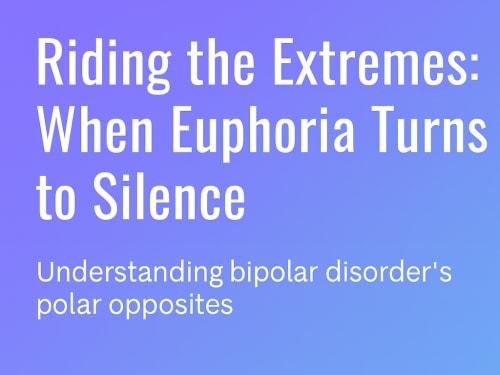Riding the Extremes of Bipolar Disorder

posted 23rd July 2025
Riding the Extremes: When Euphoria Turns to Silence – Understanding Bipolar Disorder’s Polar Opposites
The mind, in its complexity, is capable of extraordinary highs and devastating lows. For individuals living with bipolar disorder, life can feel like a never-ending pendulum swing between two powerful emotional states: the euphoric, grandiose surges of mania, and the paralysing silence of catatonic depression.
During manic episodes, a person may feel invincible—brimming with ideas, confidence, and energy. At its most intense, mania can become delusional, with grandiose beliefs about one’s abilities or importance. It might look like creative brilliance or unstoppable ambition, but beneath the surface, judgement is impaired, boundaries are blurred, and the risk of financial, professional, or relational damage is high.
At the opposite end of the spectrum lies the depressive pole: a place of emotional numbness, profound sadness, and sometimes catatonia—a state of physical and psychological immobility where even basic functioning becomes impossible. Here, the sense of purpose, joy, and meaning vanishes. These episodes are not simply “feeling low” but deeply destructive periods that can erode a person’s identity and capacity to connect with the world.
The cycle between these states can be unpredictable and exhausting. People often report feeling alienated from themselves, trapped between two extremes that neither reflect their true self nor feel controllable. This volatility can fracture relationships, disrupt work and study, and lead to feelings of shame or stigma, especially when others only witness the extremes, not the struggle to find balance in between.
Psychological therapy plays a vital role alongside psychiatric care in supporting individuals with bipolar disorder. Talking therapies can help clients make sense of their experiences, identify early warning signs, and develop personalised coping strategies to manage emotional regulation. Structured approaches such as Cognitive Behavioural Therapy (CBT) and Interpersonal and Social Rhythm Therapy (IPSRT) have been shown to support mood stabilisation and enhance insight into triggers and cycles.
Above all, bipolar disorder is not a moral failing or a personality flaw—it is a serious mental health condition that requires compassion, understanding, and skilled, sustained support. With the right treatment and psychoeducation, many people living with bipolar disorder can lead stable, fulfilling lives. The goal isn’t to eliminate all emotion, but to create a life where the mind no longer feels like an enemy—where balance, not chaos, becomes the new norm.
If you or someone you care about is experiencing mood extremes that are interfering with everyday life, it’s important to reach out. Help is available, and no one should have to navigate the darkness or the overwhelm alone.



